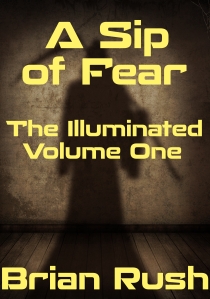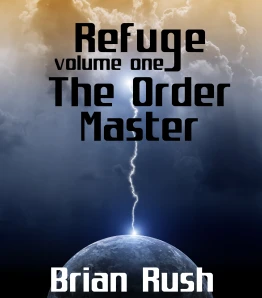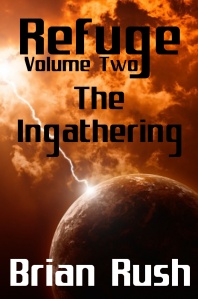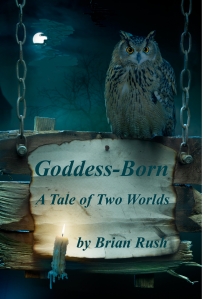I’m going to go out on a limb here and say that, for the indie writer who doesn’t sell his books in bookstores, cover design is a lot less important than some will suggest. What I mean is that a really superior cover design will not help much to sell books online. On the other hand, a poor and obviously amateur cover design may well suppress them. So cover design isn’t unimportant, it’s just not as important as we are sometimes told, in my opinion.
Here’s why I believe that. Let’s consider first of all why a great cover is really important when you’re selling books in print in physical bookstores. Surely most people reading this have had the experience of browsing in a bookstore. Maybe you go into the store initially looking for a particular book, but then again, I’ve walked into a bookstore just looking for something to read and intending to walk out again with a book, but not knowing what precisely. I go into a few sections that have books I’m interested in (fantasy and science fiction, naturally, and also history and science and spirituality). I run my eyes over the shelves. As I do so, in order for me to consider a book, my eyes have to be drawn to something. Maybe it’s an author I’ve read before but a book I haven’t read. Maybe it’s a really catchy title. Or maybe it’s a truly awesome cover, something that grabs notice from all the way across the room. That certainly won’t sell the book, but it may get me to pick it up and take a closer look, giving the book a chance to sell itself.
This process has been understood for a long time, and that’s why it’s conventional wisdom that a great cover design is a must. But if you’re buying something online, the process is very different. (It’s also visually different, and what works as a bookstore cover won’t necessarily work well as a cover for an e-book or POD, or vice-versa. I’ll get to that in a bit.) You’re a lot less likely to browse the virtual shelves the way you would the physical shelves in a real bookstore. Instead, you’ll go to Amazon or wherever you want to buy your books, and you’ll do a search for a particular book or author that’s been recommended to you. Maybe you saw it reviewed by someone you trust who raved about it. Maybe a friend gave you the author or title and told you to check it out. Maybe the friend even sent you a link by email. Maybe you were surfing social media and an author presented something about his book that caught your attention and you clicked on his link. However it came to your attention, you start interested in what you’re looking for before you even arrive at the website. The cover doesn’t have to attract your attention. The book’s already got that. About the only time that the browse-the-shelves experience is ever simulated online is when you’re looking at the book you’re interested in, and you happen to glance below where you see “Those who bought this book also bought” and a list of clickable book covers. That’s such a small portion of the online book-buying experience, compared to shelf-browsing in a bookstore, that it’s not worth investing a huge amount of effort to make your cover absolutely wonderful and eye-catching — effort that you could instead be putting into editing your book or working on your next one.
On the other hand, if you go to the link and you see a cover that’s just plain awful and amateurish, that might give you a poor first impression and drive you away, or help drive you away. In fact, common sense says it would have to. You might not even consciously realize it; you might tell yourself not to judge a book by its cover, and look at the description and the sample pages, but having gotten that poor first impression from the cover, you are more disposed to dislike the writing itself. A nice, professional-looking cover will have the opposite effect.
What does all this mean? What I think it means is that cover design isn’t unimportant — at least it’s important to achieve a certain minimum of quality and professionalism — but its importance is often overstated.
So how do you achieve that minimum of quality and professionalism? What goes into a book cover?
First off, let’s deal with that difference between a good cover for online display and one for a bookstore. In a bookstore, you can pick the book up, read the blurbs on the back, check out the small print on the front, and pay close attention to a lot of tiny details. Online, you’re not so likely to do that. So a bookstore cover can (and should) have a lot more detail and small-print information than an online cover. The online cover needs to look nice in a small thumbnail and a medium-size image that’s a lot smaller to the eye than a book in your hand. All of its visual elements need to be big enough to discern in that format. Its text needs to be large-font so as to be readable in that format, too, which means the amount of information you can include is strictly limited. As a general rule, you can fit the title, a subtitle, and the by line — and that’s it. Any blurbs, quotes, etc. have to be left off the online cover, maybe included inside to come up on the first page after the legal stuff.
So the first step is to decide how you want to market your book. You should definitely market it online; if you want to market it in bookstores, too, then I recommend having two cover designs, one for each venue. (And of course the bookstore cover will be print-only; online you will need an e-book cover for sure, and a print cover suitable for online if you’re also marketing your book in a POD version.)
There are two elements to a good cover, and hence two talents or skills that you need to either acquire or hire. These are the original art itself, and the overall graphic design. The art (which can be either a drawing/painting or a photograph) is incorporated into the graphic design along with other elements, mostly text.
Art is a talent, and to a degree so is photography. The first question to ask yourself, then, is whether you have the talent (and the skill) to produce original art. If you do, that’s fantastic. If not, you’ll need to acquire the rights to art by someone else, and this will certainly cost at least a little money. The ideal way would be to commission a work of art specifically for your book cover. That’s quite expensive, though. It’s unlikely that you’ll be able to commission a decent work of original art for less than $1,000. If you regularly sell enough books to justify that cost, go for it. If not, an ideal book cover won’t make the difference for you, so my advice is not to. You can acquire the rights to stock art for about $75. If you’re careful about choosing it, this can result in a very nice cover.
The other part, graphic design, is much less expensive. You can hire a professional e-book cover or POD cover for between $250 – $500 as long as you supply the art for it yourself using either your own artistic creations (yay, you!) or stock art. If you’re really strapped, it’s not all that difficult to acquire enough skill at graphic design to make your own. (Yes, I’m serious. You’ll be told that this is impossible, that your covers will be crap. This advice arises from professional graphic designers, however, who want your money. Consider the source.) The truth is, designing a decent e-book cover, although it does require some skill and a little aesthetic sense, is not high-end super-difficult graphic design. It’s not that hard.
Well — let’s clarify that. It’s not high-end super-challenging graphic design, but neither is it falling-off-a-log easy. You will, if you want to do it yourself and aren’t already a graphic designer, have to put some time and effort into learning how. That means acquiring a good graphics design program and learning how to use it to create a book cover. The best program for the purpose is almost certainly Adobe Photoshop, so if you have that or can afford it, use it. Among free software, the best is GIMP. That will do almost but not quite all that Photoshop will do, and for purposes of creating book covers it’s just as powerful. It’s a little harder to learn and use than Photoshop, but luckily there are good tutorials out there in video form that will show you how to make book covers with it. (Or with Photoshop.) As that’s all we’re talking about here, peruse several of those and get some practice in, and you’re good to go.
If you have to or just want to do this yourself, I advise getting quite a bit of practice in first using some simple techniques. Make covers and compare them to efforts you know are professional, such as those from the major publishing houses. (See, those guys are still good for something.) Make a dozen or so that you’re happy with, and you should be good enough to make a cover for your own book.
As I said initially, this is not as crucial as some will tell you, in my opinion. It’s not nearly as important for the quality of your book as editing. But it’s not totally unimportant, either, and it does pay to invest a good bit of time learning how to do it, or else the money to hire it done.












